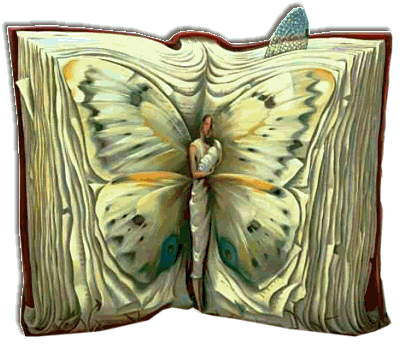Durante siglos se han ido presentando testimonios sobre la existencia de duendes, hadas y otros seres parecidos al ser humano, que parecen habitar en un extraño mundo profundamente vinculado al nuestro pero, sin embargo, separado de éste.
Las historias sobre personas que han podido ver alguno de estos seres mágicos de la naturaleza continúan hasta nuestros días. Uno de estos relatos modernos de contacto con los habitantes de este otro mundo es el de la señora Ann Atkin, de Devon, Inglaterra.
Cierto día en 1977, la señora Atkin se encontraba paseando por el camino que conduce a la puerta de entrada a su casa, cuando de pronto, se le apareció un gnomo, dándole un gran susto. Habló con ella telepáticamente (a través del pensamiento), y le entregó el siguiente mensaje: que los seres humano deberíamos tratar de armonizarnos con la naturaleza puesto que, una vez que lograramos esto, estaríamos en armonía con nosotros mismos y con los demás, y ya no destruiríamos la Tierra ni a nuestros hermanos. Además, le dijo que a los gnomos les gustaría que hubiera algún tipo de organización que defendiera sus intereses.
Por todo ello, la señora Atkin creó la "Gnome Reserve" (Reserva para Gnomos) en el jardín de su casa, convirtiéndolo en un lugar lleno de vegetación y decorado con todo tipo de figuritas de gnomos. Ahora este jardín se ha convertido en una de las atracciones más visitadas de Devon.
Su página web es la siguiente: www.gnomereserve.co.uk


Tradicionalmente, los gnomos son los guardianes de la Tierra, y serían manifestaciones del espíritu de las piedras (al igual que, por ejemplo, las salamandras son los espíritus del fuego, o las nereidas del agua, etc.). Sin embargo, creo que no deberíamos olvidar que los seres pequeños que en la actualidad denominamos gnomos no son propios del folclore anglosajón sino de Alemania y los países escandinavos, donde estos son llamados "tomten". Además, según tengo entendido, la palabra "gnomo" fue acuñada por el alquimista suizo Paracelso y vendría de la raíz griega que significa "conocimiento", es decir, los gnomos serían "sabios".
De cualquier modo, puede ser que la señora Atkin los llamara así por su parecido a los gnomos de los cuentos. He aquí un detalle interesante que Ann añadió sobre los seres que observó: "La capucha de los gnomos macho era puntiaguda, mientras que la capucha de las hembras tenía forma de espiral. Esto indica su origen: la capucha puntiaguda simboliza arriba y la espiral simboliza dentro". Si esto significara que viven en un lugar que está al mismo tiempo encima y dentro de nuestro mundo, puede que coexistan con nosotros en algún otro plano invisible y desconocido, que, sin embargo, algunas personas, como la señora Atkin, son capaces de percibir en ocasiones.
Fuente bibliográfica: "Lo inexplicado. El mundo de lo extraño, insólito y misterioso. Volumen 3", editorial Delta, S. A.
*****
For centuries, there have been appearing different testimonies on the existence of elves, fairies and other beings similar to humans, who seem to inhabit a strange world deeply connected to our own but yet separated from it. The stories about people who have seen one of these magical beings of nature continue to this day. One of these modern accounts of contact with the inhabitants of this other world is that of Mrs. Ann Atkin, of Devon, England. One day in 1977, Mrs. Atkin was walking along the road leading to the entrance to her house, when suddenly appeared a gnome, giving her a fright. He spoke to her telepathically (through thought), and delivered the following message: that human beings should try to harmonize with nature since, once we managed that, we would be in harmony with ourselves and with others, and not destroy the Earth or our brothers. In addition, he said that they would like gnomes had some kind of organization to protect their interests. Therefore, Mrs. Atkin created the "Gnome Reserve" in the garden of her house, making it a place full of greenery and decorated with all sorts of figures of gnomes. Now this garden has become one of the most visited attractions in Devon. Her website is:
Traditionally, gnomes are the guardians of the Earth, and they seem to be manifestations of the spirit of the stones (as, for example, salamanders are the spirits of fire, water or mermaids, etc.). However, I think we should not forget that small beings nowadays called gnomes don’t belong to the Anglo-Saxon folklore but to the tradition of Germany and the Scandinavian countries, where they are called "tomten". Moreover, as I have heard, the word "gnome" was coined by the Swiss alchemist Paracelsus and comes from the Greek root meaning "knowledge", that means the gnomes would be "wise."
In any case, it may be that Ms. Atkin's named them like this for their resemblance to the gnomes in fairytales. Here's an interesting detail about the things Ann said she observed: "The hood of the male gnomes was pointed, while the hood of the females had a spiral shape. This indicates their origin: the pointy hood symbolizes 'up' and the spiral one symbolizes 'inside'." If this would mean they live in a place that is at the same time above and inside our own world, they may coexist with us in some other plane, invisible and unknown, which, however, some people, like Mrs. Atkin, are able to perceive sometimes.
Bibliographical source is acknowledged: "Lo inexplicado. El mundo de lo extraño, insólito y misterioso. Volumen 3", editorial Delta, S. A.


No hay comentarios:
Publicar un comentario